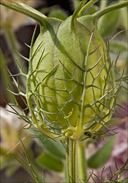|
|
click photo for larger file

Nigella damascena
Mulberry Rose
|
Photographer: Dr. Amadej Trnkoczy
ID: 0000 0000 0525 0147 (2025-05-05)Copyright © 2025 Dr. Amadej Trnkoczy
|
|
INFORMATION PROVIDED WITH THE PHOTO
|
date of photo May 13, 2007
latitude 44.36940 longitude 14.78480
View on Google Maps.
location
Zadar archipelago, island Olib, about 1 km south of the village of Olib, close to the path to South Slatina beach. (Zadar region, Croatia)family
Ranunculaceae
notes Slo.: vzhodna črnika - syn.: Nigella coerulea Lam., Erobathos damascenum (L.) Spach, Melanthium damascenum (L.) Medik. - Habitat: Abandoned agricultural land enclosed by dry stone walls, today unmaintained grassland; flat terrain, dry, sunny, open place; calcareous ground, elevation 40 m (130 feet); average precipitation ~ 950 mm/year, average temperature 13-15 °C, Mediterranean phytogeographical region. - Substratum: soil. - Comment on Flick album Nigella damascena: Nigella damascena is an annual Mediterranean plant (Ref.: 4). However, it has now been introduced to all continents, according to GBIF (Ref. 3). It is widely cultivated in horticulture due to its attractive flowers and fruits. Currently, plants with flowers in all colors, whether single, double, or triple-petaled, are available in nurseries, while wild plants typically have light blue to almost white flowers with a single row of petals. The interesting leaves surround each flower like a basket and are deeply cut into thin, linear segments. The fruits are also unusual: large, decorative, inflated seed capsules with strange 'horns' (remnants of pistils). The seeds are black and valued as a spice, particularly in confectionery (see the German vernacular name Schwarzkümmel) and in medicine. Traditional Eastern medicine has recommended them for lowering cholesterol, blood pressure, and addressing various other health problems. However, the plant's seeds and parts can be poisonous if ingested in excessive quantities. The plant also serves as an important source of honey. - The species is common on the Croatian islands and the eastern coast of the Adriatic Sea. Its morphological characteristics make it impossible to confuse it with another species in our area. - Ref.: (1) A. Martinči et all., Mala Flora Slovenije (Flora of Slovenia - Key) (in Slovenian), Tehnična Založba Slovenije (2007), p 128. (2) T. Nikolić, Flora Croatica, Vaskularna flora Republike Hrvatske, Vol. 3. Alfa d.d.. Zagreb (2020), p 451. (3) Euro+Med (2006+), Euro+Med PlantBase - the information resource for Euro-Mediterranean plant diversity. http://www.europlusmed.org [accessed May 04, 2025] (4) POWO (2024). 'Plants of the World Online. Facilitated by the Royal Botanic Gardens, Kew. http://www.plantsoftheworldonline.org/ (accessed May 04, 2025)camera Nikon D70 /Nikkor Micro 105mm/f2.8
contributor's ID # Bot_0187/2007_DSC7394 photo category: Plant - annual/perennial
|
MORE INFORMATION ABOUT THIS PLANT
|
| common names
Mulberry Rose, Love-in-a-mist, Bird's Nest (photographer)
View all photos in CalPhotos of Nigella damascena Check Google Images for Nigella damascena |
|
The photographer's identification Nigella damascena has not been reviewed. Sign in to review or comment on this photo |
|
Using this photo The thumbnail photo (128x192 pixels) on this page may be freely used for personal or academic purposes without prior permission under the Fair Use provisions of US copyright law as long as the photo is clearly credited with © 2025 Dr. Amadej Trnkoczy.
For other uses, or if you have questions, contact Dr. Amadej Trnkoczy amadej.trnkoczy[AT]siol.net. (Replace the [AT] with the @ symbol before sending an email.) |
|
|
